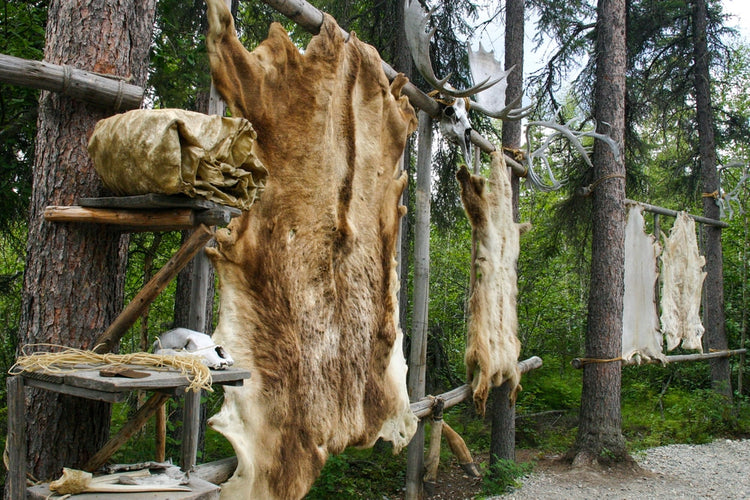
Are you interested in learning how to transform a raw animal hide into a beautiful and usable material? Look no further! In this step-by-step guide, we will walk you through the whole process of how to tan a hide from start to finish. With proper tanning techniques, you can turn a raw animal hide into a soft and durable material that can be used for a wall hanging, clothing, bags, and more.
At The Pathfinder School, we offer classes on hide tanning that will teach you the traditional methods and give you hands-on experience. But for those who can't attend our classes, don't worry — we've got you covered with this comprehensive guide. So, let's dive in and learn how to transform a tough hide into a supple and useful material!
The Basics of How to Tan a Hide
Hide tanning, a centuries-old craft, is the process of transforming raw animal hides into durable, pliable leather. This process, although meticulous, is rewarding and offers a great sense of achievement.
Tanning hides typically involves a series of steps that begin with cleaning the animal hide and removing any last remaining bits of flesh and hair. Then, the hide is soaked in a tanning solution, which helps preserve it and prevent decay.
After soaking, the hide undergoes a softening process, where it's worked over a rounded surface to make it more flexible. Lastly, the hide is smoked and oiled, enhancing its appearance and durability.
Tanning animal hides can be done using various methods, each resulting in unique textures and finishes. The method you choose for the tanning process depends on the type of hide you're working with and your personal preferences.
Understanding these basics sets the foundation for your hide tanning journey. As you delve into this craft, you'll find that tanning a hide is more than just a process, it's a bridge connecting us to our past and a testament to our resourcefulness and creativity.
Gathering Your Tanning Materials
Before you begin to tan a hide, you'll need to assemble the necessary materials. To start, you'll need a hide, ideally fresh and unprocessed. You can get one from a local butcher or hunters in your area.
For the cleaning process, a fleshing tool or knife will come in handy to remove leftover meat and fat from the hide. Next up is the tanning solution. Various options are available, including commercially produced solutions or homemade mixtures using natural materials like oak bark, tree leaves, or animal brains. The choice depends on your preference and the type of finish you want to achieve. A large tub or container is also required to soak the hide in the tanning solution. Other tools that you will need include a scraping tool for removing any residual hair or tissue and a wooden pole or similar rounded object for the softening process.
Lastly, you'll need a source of smoke and oil (like neatsfoot oil or mink oil) for the final steps of the process. Remember, having the right materials on hand can make the process of tanning a hide much smoother and more successful. Start gathering your materials and prepare to embark on your hide tanning adventure!
Prepping the Hide for Tanning

Before embarking on your hide tanning journey, it's crucial to prepare the hide properly. If you're using a deer skin or deer hide, start by spreading it out on a flat surface, fur side down. Wearing gloves is recommended for this process to protect your hands and to keep the hide clean.
Use a fleshing knife to remove any remaining meat or fat from the hide carefully. Be thorough but gentle, ensuring you don't puncture or damage the hide. Once cleaned, wash the entire hide in a solution of mild soap and warm water to remove any residual blood or grime. Rinse thoroughly until the water runs clear.
Then, hang or lay out the hide to air dry. It's essential that the whole hide itself is completely dry before you begin the tanning process.
Remember, the better the preparation, the better the results of your hide tanning. As you prepare your hide, be patient, meticulous, and, most importantly, enjoy the process! Your hide tanning adventure is just beginning.
Soaking and Scraping: A Crucial Step

With your hide properly prepped, we now step into the crucial soaking and scraping stage. Start by immersing your hide into your chosen tanning solution, ensuring it is fully submerged. During this soak, which typically lasts a week, the solution penetrates the hide, setting the stage for preservation.
It's vital to stir the solution daily to distribute the tanning agents evenly throughout the hide. After the soak, carefully remove the hide and gently scrape away any residual hair or tissue using your scraping tool. Keep in mind that gentleness is vital during this stage; heavy-handed scraping could potentially damage the hide.
It's important to remember that these processes are not rushed affairs. Your hide may need more or less time in the solution or require additional scraping based on its thickness and size. This soaking and scraping stage is indeed a time for patience, but it's also a time when you truly start to see the transformation of the raw hide into a potential piece of beautiful leather.
Applying the Tanning Solution

Now that your hide is prepped and ready, let's delve into the tanning process. For this step, make sure your tanning solution, whether commercially bought or homemade, is readily available. If you're using a homemade solution, it could be made from oak bark, tree leaves, or even the brains of the same animal whose hide you are tanning.
Immerse the hide fully into the solution and ensure every inch is covered. Leave it to soak for about a week, but remember to stir the solution daily to ensure the tanning agents are evenly distributed throughout the hide. This is a crucial step in the process, and if done correctly, it can turn your hide into a beautiful and durable piece of leather.
Keep in mind, though, that each hide is unique, so the amount of time it needs to soak may vary. Trust your instincts and pay close attention to the hide throughout this process.
Softening the Hide
With your hide thoroughly soaked and scraped, the next vital step is softening the hide. This step is where you begin to transform the tough, rigid hide into a pliable and usable piece of leather.
Begin by laying out your hide on a smooth, flat surface. Using a wooden pole or a rounded stone, start working the hide, flexing and stretching it in every direction. You'll notice the hide beginning to soften under your hands. It's a slow process, but don't rush. The more time and effort you invest in this stage, the more supple your leather will be. Pay particular attention to the edges, as these areas can be notoriously tricky to soften.
As you work the hide, you'll feel a connection to the generations who practiced this craft before us, a testament to the enduring nature of this ancient skill. Enjoy this tangible progress, for each stroke brings you closer to having a beautifully tanned hide!
The Final Steps: Smoking and Oiling
Once your hide is soft and pliable, it's time for the final steps: smoking and oiling. The smoking process helps to preserve the hide further and gives it a distinctive color. Hang the hide over a smoky fire for several hours, ensuring the smoke evenly permeates the hide.
Next, apply a layer of oil, like neatsfoot oil or mink oil, to condition and waterproof the hide. Work the oil into the hide until fully absorbed. These final steps truly bring out the beauty of your tanned hide, resulting in a stunning piece of leather.
Different Methods Used To Tan An Animal Hide
There are several methods used in tanning hides, each with unique results. The oldest and most traditional method is brain tanning, where the animal's brain is used as a tanning agent. The hide is soaked in the brain mixture, worked until soft, then smoked.
Other methods include bark tanning, where tannin-rich bark is used, and vegetable tanning, using plant-based tannins. The method chosen greatly influences the final leather product's texture, color, and durability. Each method requires patience and attention to detail, but the outcome is a beautifully preserved piece of nature.
Hide Tanning Classes At The Pathfinder School
For those eager to dive deeper into the art of how to tan a hide, The Pathfinder School offers an exceptional Hide Tanning Class. This comprehensive course covers both Fur (Hair On) and Buckskin/Leather (Hair Off) tanning, allowing students to get hands-on experience with different types of hides.
During the class, students will gain valuable insights into hide thinning and fur storage, crucial aspects of hide tanning often overlooked in self-learning. As a bonus, each student will receive a "green fur," a raw, untreated hide, to practice tanning during the course. Best of all, this piece of fur is yours to keep after the course, serving as a tangible reminder of your educational journey.
Conclusion
Tanning a hide is an immersive journey that combines tradition, science, and art. Although it requires patience and dedication, the end result is truly rewarding: a beautiful, durable piece of leather crafted by your own hands. Remember, each hide is unique, and with each tanning process, you'll gain more knowledge and experience. So get out there, gather your materials, and start your adventure in hide tanning! Happy tanning!




